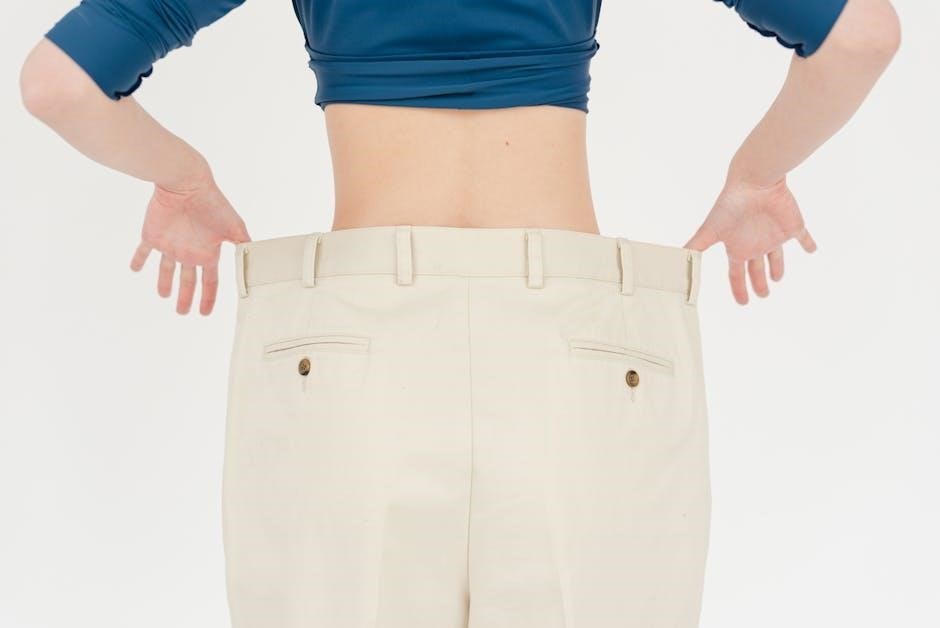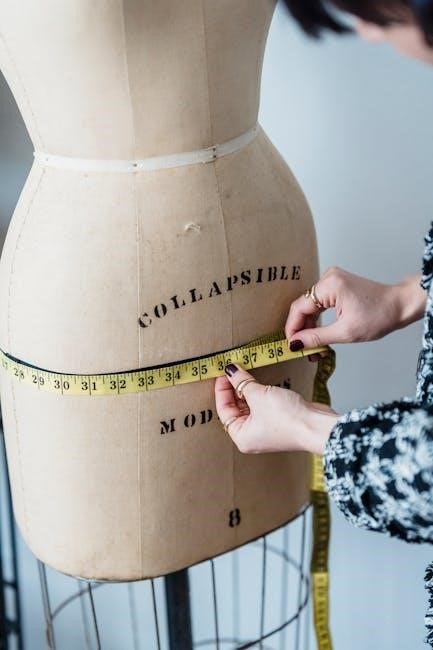Size guides are essential for ensuring a proper fit across clothing, footwear, and mattresses. They provide standardized measurements, helping consumers choose the right size, especially when shopping online. International conversions are often included, making it easier to find the perfect fit regardless of the brand or region.

Clothing Size Guide
Clothing size guides provide standardized measurements for men, women, and children, ensuring a proper fit. They include bust, waist, and hip measurements for women, and chest and waist for men. International size conversions are often available, helping shoppers find the right size across brands and regions effortlessly.
Measuring Techniques
Accurate measurements are crucial for determining the right size. Start by using a flexible tape measure and ensure it is straight and parallel to the floor. For clothing, measure the bust around the fullest part, the waist at the narrowest point, and the hips at the widest part, typically 7-9 inches below the waistline.
For footwear, measure the foot length by placing the foot flat on the ground and marking the longest toe with a ruler. International sizing varies, so refer to standardized charts for consistency. Proper measuring ensures a perfect fit, whether for clothing, shoes, or mattresses.
- Use a flexible tape measure for accurate results.
- Keep the tape measure straight and parallel to the floor.
- Measure the bust, waist, and hips for clothing.
- Measure foot length for footwear sizing.
- Consult standardized size charts for consistency.
By following these techniques, you can confidently determine your size and make informed purchasing decisions.
Women’s Size Chart
A women’s size chart provides a standardized guide to help determine the correct clothing size based on body measurements. Sizes typically range from XS (extra small) to 3XL (triple extra large) and are determined by measuring the bust, waist, and hips. The most common measurements used are:
- Bust: Measured around the fullest part of the bust, keeping the tape measure level and parallel to the floor.
- Waist: Measured at the narrowest point of the natural waistline, usually about 6-7 inches above the hipbone.
- Hips: Measured at the widest point of the hips, approximately 7-9 inches below the waistline.
Standard women’s sizes are categorized as follows:
- XS: Bust 32-33″, Waist 24-25″, Hips 34-35″
- S: Bust 34-35″, Waist 26-27″, Hips 36-37″
- M: Bust 36-37″, Waist 28-29″, Hips 38-39″
- L: Bust 38-39″, Waist 30-31″, Hips 40-41″
- XL: Bust 40-41″, Waist 32-33″, Hips 42-43″
- 2XL: Bust 42-43″, Waist 34-35″, Hips 44-45″
- 3XL: Bust 44-45″, Waist 36-37″, Hips 46-47″
These measurements are general guidelines and may vary slightly between brands. Always refer to the specific brand’s size chart for the most accurate fit.
Understanding your measurements and comparing them to the chart ensures a better fit when shopping for clothing. If your measurements fall between sizes, consider your personal preference for a snug or relaxed fit.
Men’s Size Chart
A men’s size chart is a reference guide used to determine the appropriate clothing size based on body measurements. Men’s sizes are typically categorized as Small, Medium, Large, and Extra-Large (XL), with additional sizes like 2XL and 3XL for larger frames. The key measurements used to determine men’s sizes are:
- Chest: Measured around the fullest part of the chest, keeping the tape measure level and parallel to the floor.
- Waist: Measured at the narrowest point of the natural waistline, usually just above the hipbone.
- Neck: Measured around the base of the neck, with room for comfort.
Standard men’s sizes are categorized as follows:
- S: Chest 36-38″, Waist 30-32″, Neck 14-14.5″
- M: Chest 39-41″, Waist 33-35″, Neck 15-15.5″
- L: Chest 42-44″, Waist 36-38″, Neck 16-16.5″
- XL: Chest 45-47″, Waist 39-41″, Neck 17-17.5″
- 2XL: Chest 48-50″, Waist 42-44″, Neck 18-18.5″
- 3XL: Chest 51-53″, Waist 45-47″, Neck 19-19.5″
These measurements are general guidelines and may vary slightly between brands. Some brands also offer “Slim Fit” and “Regular Fit” options, with Slim Fit being tailored closer to the body and Regular Fit offering more room for comfort. To ensure the best fit, always take accurate measurements and compare them to the specific brand’s size chart.
Understanding your measurements and how they align with the chart helps in selecting clothing that fits well and meets your personal style preferences. If your measurements fall between sizes, consider your desired fit—slim, regular, or relaxed—to make the best choice.
Children’s Size Chart
A children’s size chart is designed to help parents and guardians select the right fit for kids’ clothing based on age, height, and body measurements. These charts typically cater to infants, toddlers, and older children, with sizes divided into age ranges and specific measurements. The key measurements for children’s sizes include:
- Chest: Measured around the fullest part of the chest, ensuring comfort and room for growth.
- Waist: Measured at the natural waistline, slightly above the hipbone.
- Height: Measured from the top of the head to the floor while standing straight.
Children’s sizes are often categorized as follows:
- Infants (0-24 months): Sizes are based on age and weight, with measurements like chest (18-24″) and length (20-30″).
- Toddlers (2-6 years): Sizes range from 2T to 6T, with chest measurements from 22-28″ and heights from 32-46″.
- Boys/Girls (7-14 years): Sizes are labeled as S, M, L, and XL, with chest measurements from 28-38″ and heights from 48-60″.
When using a children’s size chart, consider factors like growth spurts and personal fit preferences. Some brands offer “slim” or “husky” options to accommodate different body types. Always measure your child accurately and compare the measurements to the chart for the best fit; If your child’s measurements fall between sizes, choose the larger size for comfort and room to grow.
Remember, size charts can vary slightly between brands, so it’s essential to refer to the specific brand’s guidelines for accurate sizing. This ensures your child’s clothing is comfortable, functional, and appropriate for their age and activity level.
International Conversions
Understanding international size conversions is crucial when shopping for clothing, footwear, or mattresses across global markets. Different countries and regions have their own sizing standards, which can lead to confusion for consumers. For example, a size 8 in the US is not the same as a size 8 in the UK or Europe. To address this, size charts often include international conversions to help individuals find their equivalent size in other regions.
Clothing sizes vary significantly between countries. For instance:
- Women’s Sizes: A US size 6 corresponds to a UK size 10, a European size 36, and a Japanese size 9.
- Men’s Sizes: A US medium is equivalent to a UK medium, a European size 50, and a Japanese medium.
- Children’s Sizes: A US size 10 for kids aligns with a UK size 11, a European size 128, and a Japanese size 11.
Footwear sizes also differ, with the US, UK, and European systems being the most common. For example, a US women’s shoe size 8 is a UK size 6 and a European size 39. Men’s sizes follow a similar pattern, with a US size 10 equivalent to a UK size 9 and a European size 44.
When shopping internationally, it’s essential to refer to the specific size chart provided by the retailer. Many brands now offer universal size charts that include conversions for different regions, making it easier for global shoppers to find the right fit. Additionally, some online tools and apps can help convert sizes between countries, ensuring accuracy and convenience.
By understanding and utilizing international size conversions, consumers can confidently purchase products from global brands, knowing their size will match across borders.
Plus Sizes
Plus sizes are designed to cater to individuals who require larger clothing options, typically starting from size 14 and above in the US sizing system. These sizes are tailored to provide a comfortable and flattering fit for individuals with curvier body types. The plus-size market has grown significantly, offering a wide range of stylish and fashionable options that were once limited.
When shopping for plus sizes, it’s important to understand that sizing can vary between brands and regions. For example, a size 16 in one brand might fit differently in another. To ensure the best fit, refer to the specific size chart provided by the retailer. Many brands now offer extended size ranges, making fashion more inclusive for all body types.
Key measurements for plus sizes often include bust, waist, and hip sizes. These measurements are crucial for determining the right fit, as clothing is designed to accommodate a fuller figure. For instance, a plus-size dress might have additional room in the bust and hips compared to standard sizes.
Additionally, plus-size clothing often incorporates features like adjustable waistbands, stretchy fabrics, and supportive structures to enhance comfort and confidence. Brands are increasingly focusing on creating garments that celebrate diverse body shapes, ensuring that plus-size individuals can enjoy the same level of style and quality as standard sizes.
By understanding your measurements and exploring the options available, you can find plus-size clothing that not only fits well but also makes you feel great. The evolution of the plus-size market has made it easier than ever to discover fashion that suits your unique needs and preferences.
Maternity Sizes
Maternity sizes are specifically designed to accommodate the changing body during pregnancy, ensuring comfort and support throughout each trimester. These sizes are not directly equivalent to standard clothing sizes but are instead based on pre-pregnancy measurements. For example, a woman who typically wears a medium in regular clothing will likely remain in the medium maternity size, even as her body changes.
Maternity clothing typically uses measurements around the natural waistline and hips to determine the best fit. Retailers often provide size charts that correlate pre-pregnancy sizes with maternity sizes, making it easier to choose the right fit. However, sizing can vary between brands, so it’s important to refer to the specific size chart provided by each retailer.
Maternity sizes are designed to accommodate growth, with features like stretchy fabrics, adjustable waistbands, and supportive structures. Many maternity clothes include ruching or empire waistlines to provide a comfortable and flattering fit. These designs allow for expansion as the belly grows while maintaining a stylish appearance.
When selecting maternity sizes, it’s crucial to focus on comfort and support. Look for items with breathable fabrics and adjustable features that can adapt to your changing body. Measuring accurately and choosing the right size early on can ensure a comfortable fit throughout your pregnancy. Remember, maternity sizes are tailored to support your body’s needs during this unique time.
By understanding how maternity sizes work and exploring the options available, you can find clothing that combines comfort, style, and functionality for every stage of your pregnancy. Always prioritize fit and support to ensure the best experience.
Choosing the Right Fit
Choosing the right fit is essential for comfort and confidence, whether you’re shopping for clothing, footwear, or other items. The key to finding the perfect fit lies in understanding your measurements and how they align with size charts. Start by taking accurate body measurements, as these serve as the foundation for selecting the correct size. Use a flexible tape measure and ensure it’s level for precise results.
When shopping, always refer to the specific size chart provided by the retailer, as sizes can vary significantly between brands. Pay attention to the fit description, such as “relaxed,” “slim,” or “regular,” to gauge how the item will sit on your body. For example, if you prefer a looser fit, you may need to size up in slim-fit styles.
Fabric type and stretch are also important factors. Stretchy materials like spandex or elastic can provide a more forgiving fit, while non-stretch fabrics may require a more precise match. Consider the activity or occasion for which you’re purchasing the item, as this can influence the ideal fit.
Finally, don’t hesitate to read reviews or seek advice from customer service if you’re unsure. Many retailers offer virtual fitting tools or size recommendation features to help you make the best choice. By combining accurate measurements, size chart guidance, and a understanding of fabric and fit, you can confidently select the right fit for your needs.
- Always measure yourself or the intended wearer.
- Refer to the retailer’s size chart for guidance.
- Consider fabric type and stretch for comfort.
- Read reviews or ask for sizing recommendations if unsure.
By following these steps, you can ensure a flattering and comfortable fit every time you shop.

Footwear Size Guide
A footwear size guide helps determine the perfect fit for shoes, ensuring comfort and support. Sizes vary by brand and style, so always check the specific chart provided. Proper fit prevents discomfort and enhances performance, making it essential for everyday wear or athletic activities.
Use foot length and width measurements to select the right size. Consider the shoe’s material and cushioning for optimal comfort. Always refer to the retailer’s size chart and read reviews for sizing insights to ensure the best fit for your needs.
Key factors:
- Measure both feet, as sizes may differ.
- Account for socks or insoles.
- Check for a comfortable toe box and heel fit.
By following these guidelines, you can find footwear that combines style, comfort, and functionality seamlessly.
Measuring Foot Length
Accurately measuring foot length is essential for selecting the right shoe size. To ensure precision, use a flat surface, such as a piece of paper or a ruler, and stand upright. Place the foot flat on the surface, with weight evenly distributed.
Use a flexible ruler or measuring tape to determine the longest point of the foot, typically from the back of the heel to the tip of the longest toe. This measurement is crucial for aligning with shoe size charts. Repeat for both feet, as they may differ slightly.
Key steps for accurate measurement:
- Stand on a hard, flat surface with the foot bare or wearing a thin sock.
- Keep the foot straight, avoiding any bending or arching.
- Place a ruler or measuring tape parallel to the floor.
- Record the measurement in inches or centimeters.
- Compare the measurement to the shoe size chart for your region or brand.
For added accuracy, measure at the end of the day, as feet tend to swell slightly. Avoid guessing or relying on previous sizes, as foot length can change over time. Using these methods ensures a comfortable and proper fit for any footwear.
Remember, precise foot length measurement is the foundation for choosing the correct shoe size, preventing discomfort and ensuring optimal support.
Women’s Shoe Sizes
Women’s shoe sizes are standardized to ensure a consistent fit across different brands and styles. In the U.S., women’s sizes typically range from 4 to 16, with half sizes available for a more precise fit. European sizes, often used internationally, range from 35 to 46, corresponding to similar U.S. sizes but with a different numbering system.
The size chart is based on foot length, measured in inches or centimeters. For example, a U.S. size 8 corresponds to a European size 39 and measures approximately 9.5 inches or 24.1 cm in foot length. Variations may occur between brands due to differences in fit and design.
Here’s a general guide for women’s shoe sizes:
| Size (US) | Size (EU) | Size (UK) |
|---|---|---|
| 4 | 35 | 2 |
| 5 | 36 | 3 |
| 6 | 37 | 4 |
| 7 | 38 | 5 |
| 8 | 39 | 6 |
| 9 | 40 | 7 |
| 10 | 41 | 8 |
When shopping, it’s important to refer to the specific size chart provided by the brand, as sizing can vary slightly. Additionally, factors like width and personal comfort preferences should be considered for the best fit.
Understanding women’s shoe sizes helps in making informed purchasing decisions, ensuring comfort and style in every pair.
Men’s Shoe Sizes
Men’s shoe sizes are designed to provide a comfortable and accurate fit for a wide range of foot shapes and sizes. In the U.S., men’s sizes typically range from 6 to 16, with half sizes available to ensure a more precise fit. European sizes, which are widely used internationally, range from 39 to 48, offering a similar progression but with a different numbering system.
The sizing is based on foot length, measured in inches or centimeters. For example, a U.S. size 10 corresponds to a European size 43 and measures approximately 9.9 inches or 25.1 cm in foot length. While most brands adhere to these standards, slight variations may occur due to differences in design and fit.
Here’s a general guide for men’s shoe sizes:
| Size (US) | Size (EU) | Size (UK) |
|---|---|---|
| 6 | 39 | 6 |
| 7 | 40 | 7 |
| 8 | 41 | 8 |
| 9 | 42 | 9 |
| 10 | 43 | 10 |
| 11 | 44 | 11 |
| 12 | 45 | 12 |
When selecting shoes, it’s essential to measure foot length accurately and consider factors like width and personal comfort preferences. Additionally, some brands offer wide or narrow fits to accommodate different foot shapes. Always refer to the brand’s specific size chart for the best fit, as slight variations may exist between manufacturers.
Understanding men’s shoe sizes ensures a comfortable and stylish fit, whether for casual wear, athletic activities, or formal occasions.
Children’s Shoe Sizes
Children’s shoe sizes are designed to accommodate the rapid growth and development of young feet. Sizes are typically categorized into three groups: infant, toddler, and youth sizes. In the U.S., infant sizes range from 1 to 4, toddler sizes from 4 to 7, and youth sizes from 7 to 13. European sizes, widely used internationally, range from 17 to 35 for children.
The sizing is based on foot length, measured in inches or centimeters. For example, a U.S. size 7 corresponds to a European size 24 and measures approximately 6.5 inches or 16.5 cm in foot length. While most brands follow standard sizing, slight variations may occur due to differences in design and fit.

Here’s a general guide for children’s shoe sizes:
| Size (US) | Size (EU) |
|---|---|
| 1 | 17 |
| 2 | 18 |
| 3 | 19 |
| 4 | 20 |
| 5 | 21 |
| 6 | 22 |
| 7 | 24 |
| 8 | 25 |
| 9 | 26 |
| 10 | 27 |
| 11 | 28 |
| 12 | 29 |
| 13 | 30 |

It’s important to measure children’s feet regularly, as they can grow up to half a size every few months. Proper fit is crucial for foot health and comfort. Some brands also offer “0” sizes for premature infants or smaller-than-average feet. Always refer to the brand’s specific size chart for the best fit, as sizing can vary slightly between manufacturers.
Choosing the right shoe size for children ensures comfort, supports healthy foot development, and prevents issues like blisters or discomfort during activity.
International Shoe Size Conversions
International shoe size conversions are essential for ensuring the correct fit when shopping across different regions. Shoe sizing systems vary significantly between countries, making it crucial to understand the equivalencies. The most common systems are the U.S., European (EU), and U.K. standards, each with distinct measurement methods.
The U.S. system is based on the Brannock device, which measures foot length in inches, while the European system uses the Paris Point scale, where one point equals 2/3 of a centimeter. U.K. sizes are similar to U.S. sizes but differ slightly in measurement.
Here’s a general guide for international shoe size conversions:
| U.S. Men’s | U.S. Women’s | EU | U.K. |
|---|---|---|---|
| 7 | 8.5 | 40 | 6 |
| 8 | 9 | 41 | 7 |
| 9 | 10 | 42 | 8 |
| 10 | 11 | 43 | 9 |
| 11 | 12 | 44 | 10 |
| 12 | 13 | 45 | 11 |
| 13 | 14 | 46 | 12 |
For example, a U.S. men’s size 10 corresponds to an EU size 43 and a U.K. size 9. Women’s sizes differ slightly, with a U.S. size 8 converting to an EU 39 and a U.K. size 6. Some countries, like China, use their own sizing systems, which are typically smaller than European sizes by about 2-3 sizes.
When shopping internationally, it’s crucial to refer to the brand’s size chart, as conversions may vary slightly. Many brands now provide dual sizing to accommodate global customers. Accurate conversions ensure a perfect fit, making online shopping across borders more reliable.
Understanding these equivalencies helps consumers avoid sizing mismatches and ensures comfort and satisfaction with their purchases.

Mattress Size Guide
A mattress size guide helps determine the perfect fit for your bed frame and personal comfort. Standard sizes include Twin, Twin XL, Full, Queen, King, and California King. Specialty sizes like Crib and Short Queen cater to specific needs. Always measure your space before purchasing.
- Twin: 39″ x 75″
- Twin XL: 39″ x 80″
- Full (Double): 54″ x 75″
- Queen: 60″ x 80″
- King: 76″ x 80″
- California King: 72″ x 84″

Standard Mattress Sizes
Standard mattress sizes are designed to fit most bed frames and provide comfort for sleepers of various preferences. These sizes are widely available and offer a consistent fit across different brands. Understanding standard sizes helps in selecting the right mattress for your needs.
- Twin: 39″ x 75″ – Ideal for children, single sleepers, or small spaces.
- Twin XL: 39″ x 80″ – Perfect for taller individuals or college dorms.
- Full (Double): 54″ x 75″ – Suitable for couples with limited space or single sleepers who prefer extra room.
- Queen: 60″ x 80″ – The most popular size, offering ample space for couples.
- King: 76″ x 80″ – Ideal for larger bedrooms and couples who want maximum comfort.
- California King: 72″ x 84″ – Best for tall individuals or those who prefer extra length.
These standard sizes ensure compatibility with bedding and furniture, making it easier to find matching sheets, frames, and accessories. Always measure your bedroom and bed frame before purchasing to ensure the best fit.
Measuring for the Right Fit
Measuring for the right fit is essential when selecting a mattress to ensure it fits perfectly in your bed frame and provides optimal comfort. Start by measuring the inside of your bed frame to confirm the mattress dimensions. Use a tape measure to check the length, width, and height of the area where the mattress will be placed.
- Measure the bed frame: Ensure the mattress fits snugly without overlapping or leaving gaps. Consider the frame’s design, as some may have extra space or unique shapes.
- Check the room dimensions: Measure doorways, hallways, and staircases if the mattress needs to be moved through them. This ensures smooth delivery and placement.
- Consider personal comfort: Lie down on the mattress to test its length and width. A mattress should be at least 6″ longer than the tallest sleeper and wide enough to accommodate partners comfortably.
Additionally, think about future needs, such as moving to a new home or rearranging your bedroom. Standard sizes are designed to fit most frames, but custom sizes may be necessary for unique setups. Always double-check measurements before ordering to avoid sizing issues. Proper measurement ensures the mattress fits seamlessly, providing the best sleeping experience.
Special Size Considerations
When selecting a mattress, special size considerations often come into play for unique situations. For example, adjustable beds or platform frames may require mattresses with specific dimensions to fit properly. Some mattresses are designed for non-traditional setups, such as RVs, boats, or antique bed frames, which may have irregular shapes or sizes.
- Custom orders: Many manufacturers offer custom-sized mattresses for unusual bed frames or spaces. Measure carefully and consult the manufacturer to ensure accuracy.
- Split sizes: For couples with differing preferences, some mattresses come in split sizes, allowing each side to have a different firmness or thickness.
- Thickness variations: Mattress thickness can impact compatibility with sheets, toppers, and bed frames. Standard thickness ranges from 8″ to 14″, but some specialty mattresses may be thinner or thicker.
- Weight considerations: Heavier individuals or those with specific medical needs may require sturdier or larger mattresses for proper support.
Additionally, consider the height of the mattress when combined with the bed frame to ensure it aligns with your preferences for ease of access. For shared beds, ensure the mattress is wide enough to accommodate all sleepers comfortably. Special size considerations ensure your mattress meets your unique needs, providing the best possible comfort and support.



